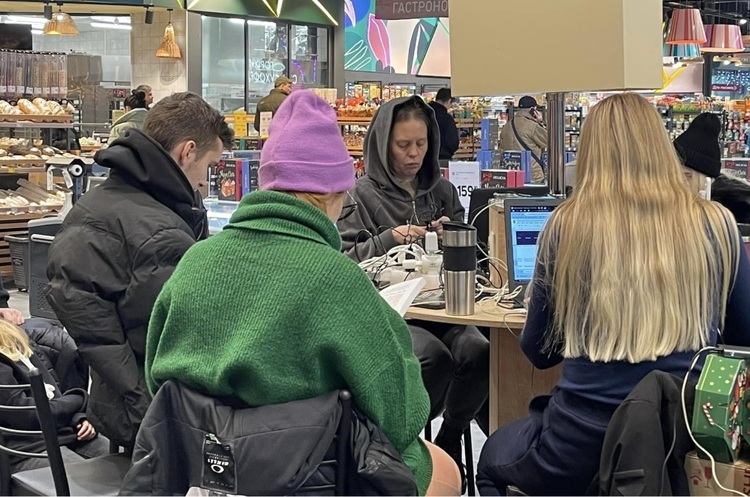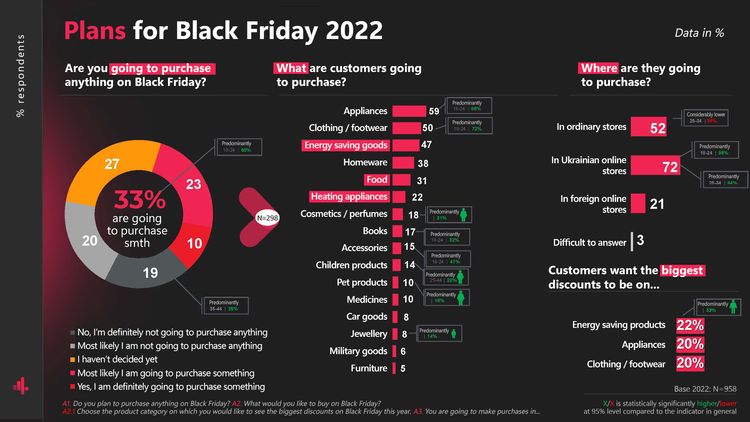Blackout adjustments: How Black Friday turned sales points into Invincibility Points
Retailers lost about 25-30% of revenues, but united Ukrainians instead

Every fifth Ukrainian planned to make a purchase on Black Friday. Retailers hoped that buyers’ attention would be focused on goods that would let them get through the blackout and winter comfortably. The main discounts were concentrated in these categories, although fewer price promo offers were envisaged than in previous years. Most retail chains scheduled the “holiday of successful shopping” for the period from 21 to 28 November. However, the massive attack on Ukrainian infrastructure, which occurred on November 23 and left 80% of the country's population without electricity for almost two days, complicated the work of sellers and cooled down consumer activity.
Mind found out what retailers expected from Black Friday 2022 and to what extent they managed to reach at least the minimum (of the desired) indicators.
What did they expect? For half of Ukrainians, the average budget for Black Friday was 5000 UAH, says Oleksandr Yampolsky, Tax and Legal Director at consulting and auditing company Deloitte Ukraine. According to him, Kyiv and Kyiv Oblast residents were ready to spend money the most, but every fourth Ukrainian expected to spend no more than 1000 UAH.
Therefore, this year retailers did not expect a huge increase in sales during Black Friday 2022.
According to Vyacheslav Sklonny, Commercial Director at the Foxtrot retail chain, a long period of promotions and discounts in all categories could theoretically lead to sales growth similar to last year, when the results of eight days of Black Friday were equal to the ones of the previous month. In particular, the network's plans in physical terms (number of boxes) are 60% from the same period in 2021.
Iryna Shynkarenko, Deputy Head of Advertising and Marketing at Epicentr, says that their sales increased by 30-40% on Black Friday in previous years. This year the retailer expected even more significant growth, given the pent-up demand and the increased need to save money.
At the same time, the marketing strategy of retailers differed from their previous ones. Market players identified a group of goods for themselves according to one of two criteria: current goods or goods of previous collections that were not sold out during the downtime.
The biggest discounts were applied to these groups to encourage customers to spend a little more money than before. Although in general the amount of discounts was not enormous. Retailers actually did not work for six months, so their priority was commercial success, which led to the reduction of price promotions in favour of maintaining business efficiency.
What was being sold? In real terms, in 2020 and 2021, the following five categories were in greatest demand during Black Friday compared to the average week: TVs, stoves and ovens, built-in hobs, vacuum cleaners, and dishwashers. But this year there was another “top five”, states Andriy Osadchy, Data Partnerships Lead at GfK Ukraine. This is due to the fact that in 2022 most of these categories experienced a significant drop compared to the previous year, as they are not essential equipment in the conditions of martial law.
Tablets and laptops, electric razors, headphones, and hair clippers have been among the leaders in terms of growth in sold pieces this year.
Ivan Pavlik, Commercial Director at Comfy, notes that the company expected increased demand during Black Friday 2022 for power banks, portable power stations, digital electronics (tablets, laptops), and the category of male beauty (trimmers, razors). Popular positions were to be goods for repairs and home improvement – in particular, ceramic tiles, laminate, parquet, paints, and wallpaper, adds Iryna Shynkarenko. Good sales of automotive goods, tableware and goods for holidays were also expected.

Experts predicted that Ukrainians would also actively buy goods intended for the winter period: clothes, heaters, and appliances. As well as equipment for tourism and outdoor activities, which will be useful both for the military and in the “field conditions” of a hard winter.
What was the reality? In the first three days of Black Friday, sales in Epicentr increased by almost 25% compared to the previous week, and in Eldorado – by more than 100%. But the blackout occurred at the end of the working week – those days when most customers usually shop around for the desired goods. The Chairman of the Allo Board of Directors Dmytro Derevytsky says that due to the russian attacks and forced power outages, the network estimates that Ukrainian e-commerce and retail lost about 25-30% of its revenue. This was caused by a cut in online traffic (up to 30% across the market) and offline traffic (up to 20%).

A number of construction hypermarkets and points of sale of household appliances, which were able to quickly establish an autonomous power supply (Epicentr, Moyo, Allo), after the attacks on November 23, turned into improvised Invincibility Points.
People came there not only to shop, but also to recharge their gadgets or try to call their relatives.
“We consider the Black Friday campaign not as a tool to increase profits, but as an opportunity to strengthen the loyalty of our customers. Unfortunately, this year profits in most sectors of Ukrainian business have faded into the background,” summarises Iryna Shynkarenko from Epicentr.
If you have read this article to the end, we hope that means it was useful for you.
We work to ensure that our journalistic and analytical work is of high quality, and we strive to perform it as competently as possible. This also requires financial independence. Support us for only UAH 196 per month.
Become a Mind subscriber for just USD 5 per month and support the development of independent business journalism!
You can unsubscribe at any time in your LIQPAY account or by sending us an email: [email protected]


